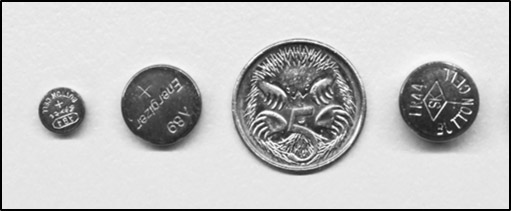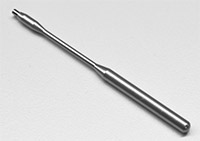View resources
Key points
- Consequences of aural foreign bodies range from local irritation at insertion site, to serious complications including permanent hearing loss.
- Urgent ENT referral (onsite or via RSQ) is required for button batteries due to the risk of necrosis of surrounding tissue.
- The first attempt at removal of a foreign body from the ear has the best chance of success.
- Refer to ENT if first attempt (via any method) is unsuccessful
Purpose
This document provides clinical guidance for all staff involved in the care and management of a child presenting to an Emergency Department (ED) in Queensland with a suspected or confirmed foreign body in the ear.
This guideline has been developed by senior ED clinicians and Paediatricians across Queensland, with input from ENT, Queensland Children’s Hospital, Brisbane. It has been endorsed for use across Queensland by the Queensland Emergency Care of Children Working Group in partnership with the Queensland Emergency Department Strategic Advisory Panel and the Healthcare Improvement Unit, Clinical Excellence Queensland.
Introduction
Aural foreign bodies are more common in the following children:
- pre-school age or older children with intellectual impairment
- underlying middle-ear problems (Eustachian tube dysfunction, otitis media with effusion)
- pica or attention deficit hyperactivity disorder
Beads, plastic toys, pebbles and food are the most common objects inserted. Older children may present with insects in the external auditory canal. Foreign bodies are most frequently found in the right ear due to predominant right handedness.
Button batteries
Button batteries require immediate removal due to the risk of necrosis of the surrounding tissue.

There are two main mechanisms by which button batteries can cause necrosis:
- where there is sufficient retained battery charge, hydrolysis and creation of hydroxide ions in adjacent tissues leads to mucosal burn at battery’s negative pole
- direct pressure
Despite prompt removal, the risk of injury can continue up to weeks post-insertion due to residual alkali and weakened tissues.
Assessment
Button batteries require immediate removal to prevent necrosis of surrounding tissue.
When to suspect a foreign body in the ear
Most children with a foreign body in the ear canal are asymptomatic. A history of insertion may be reported by the child or the caregiver. The foreign body may have been visualised on routine otoscopy. Delayed presentations are usually triggered by parents noticing blood stained purulent discharge or a bad smell.
Regardless of a history of insertion, consider an aural foreign body in children presenting with any of the following symptoms:
- ear pain
- hearing loss
- otorrhoea
- sensation of ear fullness
- tinnitus (associated with live insects)
- intractable hiccups or coughing
- purulent or blood discharge from ear
Differential diagnoses
| Differential diagnoses for suspected aural foreign body |
|---|
| Cholesteatoma |
| Infection |
| Trauma |
Investigations
X-rays are recommended if there is the possibility of button battery insertion which cannot be directly visualised.
Contact Retrieval Services Queensland (RSQ) to arrange urgent transfer of a child with a suspected button battery in the ear and no X-ray facilities onsite.
Management
Refer to flowchart [PDF 209.1 KB] for a summary of the emergency management for a child with an aural foreign body.
Urgent ENT referral (onsite or via RSQ) is required for a child with an aural button battery.
Refer to ENT as per local practices in the following circumstances:
- potentially penetrating foreign bodies
- multiple failed attempts at removal prior to ED presentation
- impacted foreign body in medial external auditory canal
- foreign body is next to tympanic membrane (especially if smooth or spherical)
Principals of foreign body removal
- first attempt offers the best chance of success
- choose the best method based on exact location, shape and composition of foreign body
- be aware of the risk of trauma (which can cause permanent hearing loss) in a poorly compliant child
Preparation for foreign body removal
- engage two staff members to assist (in addition to carer)
- provide developmentally appropriate information and encouragement and use demonstration or role play to prepare the child for the procedure
- position the child appropriately (upright or lying down)
- upright positioning encourages a sense of control thereby minimising distress
- ideal upright positioning is on the carer’s lap with his/her head supported by staff member
- may be easier to secure younger children lying down
- refer to CHQ Nursing Standard 62111: Clinical Holding – Holding and Supporting Children [PDF] (QH only)
- use auditory and visual distraction techniques and promote child’s coping skills
- use a head lamp (+/- magnification) to optimise visualisation and allow the use of two hands
Regional auricular blocks are not recommended as are rarely tolerated (due to the multiple punctures required) and may not produce complete anaesthesia.
Methods of removal
| Extraction method | Indication and notes | |
|---|---|---|
| Mechanical extraction |
Forceps (including Magill, alligator, packing, toothed and non-toothed forceps) |
|
|
Probe/ hook/ curette (including Jobson-Horne probe, cerumen hooks) |
| |
| Suction |
| |
Magnetic device |
| |
| Irrigation |
| |
Irrigation is contraindicated in the following cases:
- suspected perforated tympanic membranes including those with tympanostomy tubes (grommets)
- button battery, vegetable matter or expandable foreign body
Removal using irrigation
- place child in a supine position with the affected ear up
- if removing an insect instil mineral oil or 1% lignocaine to kill it prior to irrigation
- irrigate with warm water using a 14/16-gauge plastic IV catheter with a 30 or 60ml syringe
- direct stream along the posterior and superior margin of the external auditory canal and repeat as required
- the foreign body may be completely expelled or moved towards auditory meatus allowing mechanical extraction.
Refer to ENT as per local practice if the first attempt at removal of foreign body (via any method) is unsuccessful.
Post-removal care
- inspect auditory canal to exclude co-existing foreign body and trauma
- examine other nasal and aural orifices for additional foreign bodies
- manage concurrent otitis externa as per otitis externa guideline
There is no evidence for prophylactic use of antimicrobial drops if there has been minor trauma to the external auditory canal following foreign body removal. Consider drops only in cases where there has been mucosal breach.
| Topical corticosteroid and antimicrobial dosing for children with significant external auditory canal trauma following foreign body removal | ||
|---|---|---|
| No perforation | Dexamethasone 0.05% + framycetin 0.5% + gramicidin 0.005% ear drops (SOFRADEX®) | Three drops instilled into the affected ear, three times daily for three to seven days. |
| Perforation | Ciprofloxacin 0.3% ear drops (CILOXAN®) | Five drops instilled into affected ear two times daily for three to seven days. |
Potential complications following removal
- external auditory canal abrasion or laceration
- tympanic membrane perforation
- ossicle damage with potential for permanent hearing loss
- middle ear damage – may manifest as hearing loss, vestibular symptoms, otorrhoea, marked pain or facial nerve palsy
Refer to ENT as per local practice in child with significant complications
Escalation and advice outside of ED
Clinicians can contact the services below to escalate the care of a paediatric patient as per local practices. Button battery cases require urgent transfer if removal onsite is not possible. Other aural foreign bodies requiring specialist referral are usually managed as an outpatient.
Button battery insertions
Button batteries require immediate removal to prevent necrosis of surrounding tissue.
| Service | Reason for contact | Who to contact |
|---|---|---|
| ENT | For urgent removal of button battery | Onsite or via Retrieval Services Queensland (RSQ). For facilities with no onsite service contact RSQ (Ph: 1300 799 127) to request urgent transfer of a child:
RSQ (access via QH intranet). Notify early of children potentially requiring transfer. |
Other insertions
| Reason for contact by clinician | Contact |
|---|---|
For the management of children with the following aural foreign bodies:
For specialist advice regarding significant complications following successful removal of foreign body in ED. | Onsite/local ENT service as per local practices. Contact Children’s Advice and Transport Coordination Hub (CATCH) 07 3068 4510 (24-hour service) if no local service. |
| For access to generalist and specialist acute support and advice via videoconferencing, as per locally agreed pathways, in regional, rural and remote areas in Queensland. |
Telehealth Emergency Management Support Unit (TEMSU) 1800 11 44 14 (24-hour service) TEMSU access via QH intranet) |
Disposition
A child may be discharged following successful removal of the foreign body.
On discharge, provide accident prevention advice to caregiver/s including:
- safe storage of small objects including marbles, coins, button batteries and balloons to ensure out of reach of infants and young children
- ensuring toys for play are appropriate for developmental age
Follow-up
- advise caregiver/s to seek medical attention if child experiences hearing loss, vestibular symptoms, otorrhoea, marked pain or facial nerve paralysis
- if topical antibiotics have been prescribed, follow-up with GP in 48-72 hours
- refer any child with significant trauma to the tympanic membrane or middle ear following foreign body removal to ENT as per local practice
-
Document ID: CHQ-GDL-60022
Version number: 3.0
Supersedes: 2.0
Approval date: 02/03/2023
Effective date: 02/03/2023
Review date: 02/03/2025
Executive sponsor: Executive Director Medical Services
Author/custodian: Queensland Emergency Care Children Working Group
Applicable to: Queensland Health medical and nursing staff
Document source: Internal (QHEPS) + External
Authorisation: Executive Director Clinical Services
Keywords: Foreign body, ear, aural, button battery, ENT, paediatric, emergency, guideline, children, 60021
Accreditation references: NSQHS Standards (1-8): 1, 3, 4, 8
-
This guideline is intended as a guide and provided for information purposes only. View full disclaimer.
Last updated: October 2023